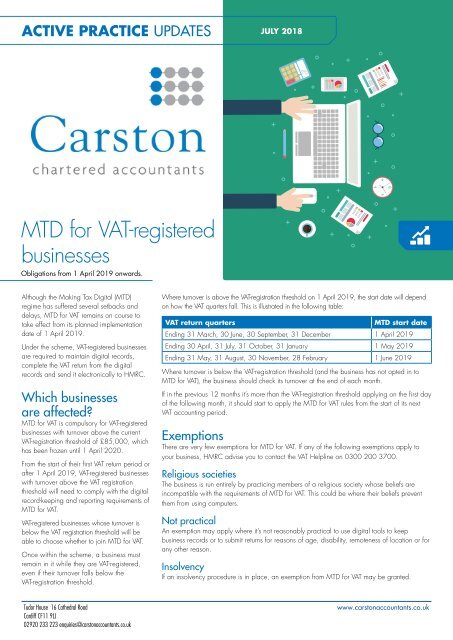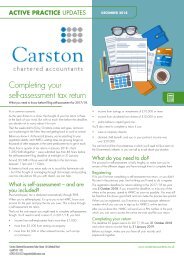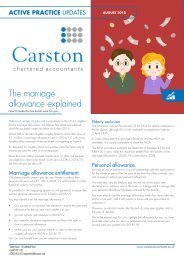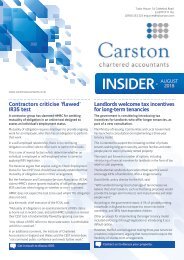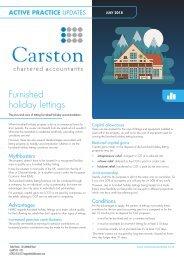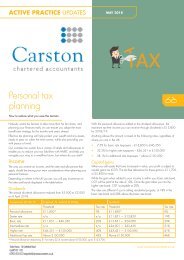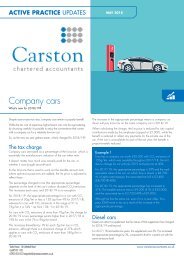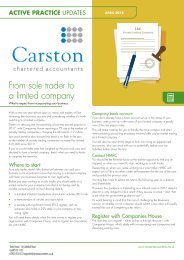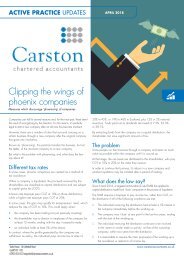MTD for VAT
MTD for VAT Registered Businesses
MTD for VAT Registered Businesses
Create successful ePaper yourself
Turn your PDF publications into a flip-book with our unique Google optimized e-Paper software.
ACTIVE PRACTICE UPDATES JULY 2018<br />
<strong>MTD</strong> <strong>for</strong> <strong>VAT</strong>-registered<br />
businesses<br />
Obligations from 1 April 2019 onwards.<br />
Although the Making Tax Digital (<strong>MTD</strong>)<br />
regime has suffered several setbacks and<br />
delays, <strong>MTD</strong> <strong>for</strong> <strong>VAT</strong> remains on course to<br />
take effect from its planned implementation<br />
date of 1 April 2019.<br />
Under the scheme, <strong>VAT</strong>-registered businesses<br />
are required to maintain digital records,<br />
complete the <strong>VAT</strong> return from the digital<br />
records and send it electronically to HMRC.<br />
Which businesses<br />
are affected?<br />
<strong>MTD</strong> <strong>for</strong> <strong>VAT</strong> is compulsory <strong>for</strong> <strong>VAT</strong>-registered<br />
businesses with turnover above the current<br />
<strong>VAT</strong>-registration threshold of £85,000, which<br />
has been frozen until 1 April 2020.<br />
From the start of their irst <strong>VAT</strong> return period or<br />
after 1 April 2019, <strong>VAT</strong>-registered businesses<br />
with turnover above the <strong>VAT</strong> registration<br />
threshold will need to comply with the digital<br />
record-keeping and reporting requirements of<br />
<strong>MTD</strong> <strong>for</strong> <strong>VAT</strong>.<br />
<strong>VAT</strong>-registered businesses whose turnover is<br />
below the <strong>VAT</strong> registration threshold will be<br />
able to choose whether to join <strong>MTD</strong> <strong>for</strong> <strong>VAT</strong>.<br />
Once within the scheme, a business must<br />
remain in it while they are <strong>VAT</strong>-registered,<br />
even if their turnover falls below the<br />
<strong>VAT</strong>-registration threshold.<br />
Where turnover is above the <strong>VAT</strong>-registration threshold on 1 April 2019, the start date will depend<br />
on how the <strong>VAT</strong> quarters fall. This is illustrated in the following table:<br />
<strong>VAT</strong> return quarters<br />
<strong>MTD</strong> start date<br />
Ending 31 March, 30 June, 30 September, 31 December 1 April 2019<br />
Ending 30 April, 31 July, 31 October, 31 January 1 May 2019<br />
Ending 31 May, 31 August, 30 November, 28 February 1 June 2019<br />
Where turnover is below the <strong>VAT</strong>-registration threshold (and the business has not opted in to<br />
<strong>MTD</strong> <strong>for</strong> <strong>VAT</strong>), the business should check its turnover at the end of each month.<br />
If in the previous 12 months it’s more than the <strong>VAT</strong>-registration threshold applying on the irst day<br />
of the following month, it should start to apply the <strong>MTD</strong> <strong>for</strong> <strong>VAT</strong> rules from the start of its next<br />
<strong>VAT</strong> accounting period.<br />
Exemptions<br />
There are very few exemptions <strong>for</strong> <strong>MTD</strong> <strong>for</strong> <strong>VAT</strong>. If any of the following exemptions apply to<br />
your business, HMRC advise you to contact the <strong>VAT</strong> Helpline on 0300 200 3700.<br />
Religious societies<br />
The business is run entirely by practicing members of a religious society whose beliefs are<br />
incompatible with the requirements of <strong>MTD</strong> <strong>for</strong> <strong>VAT</strong>. This could be where their beliefs prevent<br />
them from using computers.<br />
Not practical<br />
An exemption may apply where it’s not reasonably practical to use digital tools to keep<br />
business records or to submit returns <strong>for</strong> reasons of age, disability, remoteness of location or <strong>for</strong><br />
any other reason.<br />
Insolvency<br />
If an insolvency procedure is in place, an exemption from <strong>MTD</strong> <strong>for</strong> <strong>VAT</strong> may be granted.<br />
Tudor House 16 Cathedral Road<br />
Cardiff CF11 9LJ<br />
02920 233 223 enquiries@carstonaccountants.co.uk<br />
www.carstonaccountants.co.uk
<strong>MTD</strong> <strong>for</strong> <strong>VAT</strong>-registered businesses<br />
Digital records<br />
Certain records must be kept digitally within functional compatible<br />
software under <strong>MTD</strong>, and be preserved <strong>for</strong> up to six years. These include:<br />
Designatory data<br />
It’s compulsory <strong>for</strong> you to keep a digital record of your business’ name and<br />
an address, which is the principal place of business.<br />
Your business’ <strong>VAT</strong>-registration number and a record of any accounting<br />
schemes used must also be recorded digitally.<br />
Supplies made<br />
For each supply made by your business, you must record the time it was<br />
supplied, how much it was worth at the time and the rate of <strong>VAT</strong> charged.<br />
Multiple supplies made at the same time don’t need to be<br />
recorded separately.<br />
The total value of supplies on each invoice or receipt that have the<br />
same time of supply and rate of <strong>VAT</strong> can be recorded.<br />
A record must also be kept of output values <strong>for</strong> the period split between<br />
standard rate, reduced rate, zero rate, exempt and outside the scope outputs.<br />
Supplies received<br />
For each supply your business receives, you need to record the time of<br />
supply, the value of supply (including any <strong>VAT</strong> that cannot be reclaimed),<br />
and the amount of input tax to be claimed.<br />
If there is more than one supply on an invoice, the totals from the invoice<br />
can be recorded.<br />
The <strong>VAT</strong> account<br />
The <strong>VAT</strong> account provides the link between the digital <strong>VAT</strong> records and the<br />
<strong>VAT</strong> return submitted to the Revenue.<br />
Under <strong>MTD</strong> <strong>for</strong> <strong>VAT</strong>, the in<strong>for</strong>mation which must be held in the <strong>VAT</strong> account<br />
must be maintained digitally and this is referred to as the ‘electronic account’.<br />
To demonstrate a link between the output tax in the business records and the<br />
output tax on the <strong>VAT</strong> return, the electronic account must contain a record of:<br />
• output tax owed on sales<br />
• output tax owed on acquisitions from other EU member states<br />
• any tax to be paid on a supplier’s behalf under a reverse<br />
charge procedure<br />
• any tax owed following a correction or error adjustment<br />
• any other adjustment required by the <strong>VAT</strong> rules.<br />
Similarly, to demonstrate the link between the input tax in the business<br />
records and the input tax on the <strong>VAT</strong> return, the electronic account<br />
must contain a record of:<br />
• input tax which can be claimed on business purchases<br />
• input tax allowable on acquisitions from other EU member states<br />
• tax that can be reclaimed following a correction or error adjustment<br />
• any other necessary adjustment.<br />
Where adjustments are required, only the total value <strong>for</strong> each type of<br />
adjustment will need to be kept digitally.<br />
However, while the underlying calculations don’t have to be made<br />
digitally or using software, and can be per<strong>for</strong>med manually or by using<br />
spreadsheets if preferred, using software should reduce the risk of errors.<br />
The electronic account is vital as the in<strong>for</strong>mation held in it will be used to<br />
calculate and complete the <strong>VAT</strong> return using functional compatible software.<br />
What is ‘functional<br />
compatible software’?<br />
‘Functional compatible software’ is the cornerstone of <strong>MTD</strong> <strong>for</strong> <strong>VAT</strong>.<br />
It will be used to maintain the compulsory digital records, calculate the<br />
return and submit it to HMRC via an application programme interface (API).<br />
Functional compatible software is simply the name given to a software<br />
program, or set of compatible software programs, which are capable of:<br />
• recording and preserving records in an electronic <strong>for</strong>m<br />
• providing in<strong>for</strong>mation and returns from the records to HMRC in<br />
an electronic <strong>for</strong>m using the API plat<strong>for</strong>m<br />
• receiving in<strong>for</strong>mation from HMRC.<br />
It’s possible to mix and match software – the complete set of digital records<br />
needed <strong>for</strong> <strong>MTD</strong> <strong>for</strong> <strong>VAT</strong> don’t need to be held in one piece of software.<br />
As long as there is a link between the different pieces of software, the<br />
records can be held in a range of acceptable digital <strong>for</strong>mats.<br />
The link between the software is key, and is a legal requirement where a set<br />
of compatible software programs is used.<br />
HMRC is likely to produce a list of software from commercial software<br />
suppliers which can be used <strong>for</strong> <strong>MTD</strong> <strong>for</strong> <strong>VAT</strong>.<br />
Completing and submitting <strong>VAT</strong> returns<br />
The <strong>VAT</strong> return is calculated from the digital records maintained in the<br />
functional compatible software, and a business will need to conirm the<br />
return is correct be<strong>for</strong>e sending it to HMRC.<br />
Once submitted, conirmation the return has been received by HMRC will<br />
be received via the software, while <strong>VAT</strong> returns can be submitted by us on<br />
behalf of your business.<br />
Getting ready<br />
The countdown has begun and <strong>VAT</strong>-registered businesses need to start<br />
getting ready.<br />
It’s important to understand what’s required and what records must be<br />
held digitally.<br />
It’s also important to decide what software will suit the business, and<br />
whether a single piece of software or a set of software will be best <strong>for</strong> you.<br />
Once you have decided, you should make checks to ensure everything is<br />
up and running by the relevant start date.<br />
HMRC has promised a soft landing – but, as always, it pays to be prepared.<br />
Get in touch to discuss <strong>MTD</strong>.


